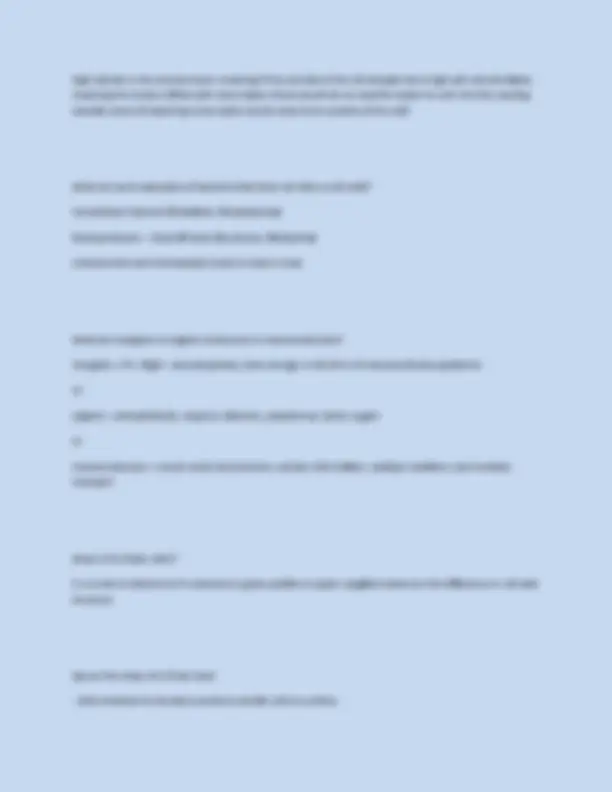





















Study with the several resources on Docsity

Earn points by helping other students or get them with a premium plan


Prepare for your exams
Study with the several resources on Docsity

Earn points to download
Earn points by helping other students or get them with a premium plan
Community
Ask the community for help and clear up your study doubts
Discover the best universities in your country according to Docsity users
Free resources
Download our free guides on studying techniques, anxiety management strategies, and thesis advice from Docsity tutors
BIOL 3270 Exam 1: What Are Microbes Made Of? General Microbiology With Laboratory Exam 2025-2026 Solved Questions And Full Answers.
Typology: Exams
1 / 27

This page cannot be seen from the preview
Don't miss anything!




















what are microbes?
single celled and very diversely shaped forms of life that include bacteria, archaea, yeast, viruses, etc and that are too small to be seen with the naked eye and are very diverse in shape (rods, balls, etc)
what gene is universal in bacteria?
16s rRNA
what are the 3 rules of microbiology?
what is the range of microbe sizes?
they can range from 0.4 microns (prochlorococcus marinus) to 100 microns (paramecium)
what is the significance of prochlorococcus marinus?
it is one of the smallest and most abundant bacterial cells and can perform photosynthesis to where it can fix CO2 and convert it into sugar and O2 -- it is responsible for 20% of the oxygen you breathe everyday
how do bacteria collectively constitute the major portion of biomass on earth?
carbon: equal to all plants on Earth; nitrogen: 10x all plants on Earth; phosphorus: 10x all plants on Earth
what is the significance of Bacillus infernus?
it was isolated from a 2-mile deep well meaning it was surviving with no light, no oxygen, high pressure, and high temperature
what is the significance of Yersinia pestis?
in 14th century killed a large population (black death)
do men or women have more diverse microbes on their fingertips?
women
What is the size of E. coli?
what shape does the name Spirillum denote?
spiral (ex. spirillum minus)
why is morphology not a good predictor of the evolutionary relationship of microbes or the species they belong to?
there are not enough distinguishable traits between bacteria; i.e if two bacteria where spherical shapes we could still not predict how close they are in species
what sets the morphology of a particular species?
optimization for nutrient uptake, swimming motility in viscous environments, gliding motility
given that mitochondria originated from proteobacteria, would it resemble closeness to E.coli or B. anthracis?
E. Coli; mitochondria is homologous (shares common ancestry to E.coli)
is archaea closer to eukarya or prokarya?
eukarya as it splits before the root (last common ancestor)
why is bacterial shape limited?
shape is determined by the trade off between three tasks and those that are unusual shapes tend to not survive -- there is a reason for limited shapes
what are longer rods and curved structure shapes better for?
maneuverability
what are shorter rod shaped structures better for?
swimming mobility
what bacterial shape is easiest to make?
coccus, or a very tiny rod shape
what is the relationship of surface area and volume in cells?
when the spherical shape becomes smaller, the surface area becomes larger
why are some bacterial cells so large if a microbe should thrive better at small sizes?
some bacteria, including nitrate bacteria (Thiomargarita magnifica), may store energy with their large volume
what are the all advantages of being small for a microbe (prokaryotes)?
can bacterial cells that are 0.1-0.2 microns survive?
Many bacteria cells that are 0.1-0.2 microns in size often cannot contain all the necessary things (like a cell wall, flagella, capsules, etc) to function properly and often are supplied by their hosts. some also adapt as endospores while trying to conserve energy
what is the lower limit of cell size meaning what are all the things a living cell has to have and takes up space within the cell?
a chromosome, proteins to copy the chromosome and express genes, with a minimum of 300 genes to survive -- all of this stuff takes up space
what is the most abundant bacterial species?
pelagibacter ubique
what is the role of the cytoplasmic (cell) membrane of a bacterial cell?
a thin 6-8 nanometer wide barrier that surrounds the cell and separates the cytoplasm from the cell's environment
what are the distinctive features of the cell membrane?
a phospholipid bilayer (leaflets) that contains a hydrophobic fatty acid tails (hydrophobic core) and hydrophilic components (glycerol phosphate head, negatively charged, polar) with a fluid membrane
what would happen if you added 70% ethanol (a strong solvent) to the cell membrane?
Will destroy the cell membrane - tails cannot interact with ethanol and will cause changes in the packing of tails because it is a solvent (means it can dissolve in water)
Ethanol: dissolves both polar and nonpolar substance and destroys the folded structure of proteins
what is the role of the cell membrane as a permeability barrier?
prevents leakage and functions as a gateway for transport of nutrients in and out of the cell because of their hydrophobic/hydrophilic features-- functions to keep water soluble proteins and other components within the cytoplasm
what is the role of the cell membrane as a protein anchor?
it is the site of many proteins involved in transport, bioenergetics, and chemotaxis -- involved in import/export of nutrients and toxins, and generation of ATP
what is the role of the cell membrane in energy conservation?
site of generation and use of the proton motive force (a way of conserving energy) -- since bacteria do not have mitochondria they are able to generate energy (ATP) on their cell membrane
why do polar (charges uneven) and charged molecules require specific protein transporters to pass through the cell membrane?
due to hydrophobic regions -- need very specific transporters for each molecule
describe the function of membrane proteins.
what do membrane proteins require?
a hydrophobic portion that is soluble within the membrane
what is passive diffusion? give examples of molecules that would participate in this diffusion.
diffusion of a solute through a membrane down its concentration gradient without a transport protein
ex: small uncharged molecules including (O2, CO2, H2O) -- NOT large, polar, charged molecules
What is osmosis?
diffusion of water across a selectively permeable membrane where its aim is to maintain a concentration that is higher inside than outside the cell with the concentration of water therefore being lower inside than outside
what is osmotic pressure?
the pressure required to stop the flow of solvent molecules from a dilute solution to a concentrated solution through a semi-permeable membrane, as solvents like water, that pass from a dilute solution to a highly concentrated one inside the cell can actually cause the cell to burst
what ions require transport proteins (transporters)?
inorganic ions (Na+, Cl-, K+)
what are transport proteins?
proteins that obtain energy for active transport by cotransport of another substance down its gradient or by coupling to a chemical reaction
what is active transport?
transport from lower to higher concentration and requires energy
what is cardiolipin?
A double phospholipid linked by glycerol that increases in bacteria grown to starvation (lack of nutrients) or stationary phase
microorganisms that use FeIII as an electron acceptor are key components of the deep hot biosphere where after after acception, FeIII is reduced to FeII
what is the pressure of a cell equivalent too?
car tire 32 PSI due to osmotic stress
what is the function of the cell wall?
support and protect the cell membrane from osmotic stress**
describe the cell wall of bacteria.
A single molecule peptidoglycan wall composed of disaccharides and amino acids that gives bacteria structural support. It has maximal volume with minimal surface area and is highly porous to ions and organic molecules (in gram negative bacteria). It is often a target for antibiotic treatment.
describe peptidoglycan.
Repeating framework of long glycan (disaccharide) chains cross-linked by 4 short peptide (amino acid) fragments -- transpeptidase does the cross linking
describe how cross bridges are formed in peptidoglycan
NAM forms amide link with amino terminus of short peptide -- the cross bridges are formed by removal of second D-alanine at end of the amino acid (peptide) chain to then form a covalent bond with the other peptide chain's NAM
how does peptidoglycan prevent osmotic shock within the bacterial cell?
in gram positive bacteria, the cell wall limits the volume of the closed cell by generating tugor pressure which presses the cell wall against the cell membrane, whereas in gram negative bacteria, the outer membrane tends to prevent a lot of osmotic shock
what carries out the process of the bonding of the two amino acid (peptide chains) groups?
transpeptidase
what is a target of transpeptidase?
antibiotics which bind to the terminal D-Ala-D-Ala and prevent removal of terminal D-alanine and therefore without removal, the two glycan chains with amino acid side chains cannot be covalently (peptide) bonded to rebuild the cell
what are the lysozymes role in bacteria and how does adding antibiotics affect the bacteria's growth?
lysozymes "destroy" their own cell wall by creating gaps in the chain, so that the cell can grow larger.
By adding antibiotics you can inhibit the transpeptidase and when the cell wall is broken they will not be able to repair and grow
In order for antibiotics to act properly the cells have to be actively growing (if they are not actively growing the peptidoglycan will already be covalently bonded) - if they are not growing the antibiotics will not kill the bacterial cells
why would some bacterial cells not have a cell wall?
describe Gram positive bacteria
contain multiple layers of peptidoglycan, but is still one molecule due to cross links; the peptidoglycan layers are reinforced by teichoic acids which have negative charges that retain the Gram stain
what are sortases in Gram positive bacteria?
responsible for covalently attaching specific proteins that help acquire specific nutrients needed by the bacterial cell
what is the S layer of Gram positive bacteria?
the protein membrane; multiple units of protein or glycoprotein; rigid but allows substances to pass through -- helps pathogens bind and attack host cells by allowing stuff out of cell
give examples of Gram positive bacteria
Bacillus anthracis, Streptococcus Pneumoniae - Firmicutes phylum
describe Gram negative bacteria
contain a thin layer of peptidoglycan (thin cell wall), periplasmic space (containing the cell wall) and enzymes, and an outer membrane which contains the following:
describe the lipoproteins found in the outer membrane of Gram-negative bacteria.
inward facing leaflet; connects the outer membrane to the peptide bridges of the cell wall
Describe Lipopolysaccharide (LPS) found in the outer membrane of Gram-negative bacteria.
outward facing leaflet that protects bacterial cells from the immune system of hosts after creating possibly lethal inflammatory responses
describe the Lipid A component of LPSs
a hydrophobic tail (remember its a lipid) used for anchoring and is recognized by immune system; endotoxic part of LPS
when is an endotoxin harmless?
when the pathogen remains intact -- once lysed when the cell undergoes cell division, they can cause sepsis
what happens when something binds to the toll-like receptors?
a signal is sent to the nucleus to synthesize/release pro inflammatory cytokines
what is the function of the porins found on the outer membrane in Gram-negative bacteria?
they permit entry of nutrients such as sugars and peptides; contain a beta barrel conformation and have limited specificity meaning they allow passive uptake of molecules including derivative antibiotics like ampicillin to where those charged groups are attracted to the charged amino acid residues and is allowed entry
what is the periplasm in Gram negative bacteria?
home of the cell wall in Gram negative bacteria (between outer and cell membrane) -- contains enzymes and nutrient transporters
why are antibiotics not very effective against Gram negative bacteria?
the outer membrane protects the cell wall from any destruction BUT adding amino groups to an antibiotic could potentially allow the transporters to transport it into the cell for destruction of the cell wall
what are capsules in bacteria and how do they aid in invasion of the immune system?
polysaccharide layers that assist in attachment to surfaces (including host cells) due to their own "sticky" surface. they aid in the invasion of the immune system and avoid phagocytosis by WBCs, enabling the pathogen to persist in the blood. they also resist desiccation (drying out) by trapping water and nutrients -- often used to distinguish between different bacterial species
what is Xanthan gum?
a bacterial capsule that appears slimy; found in things like salad dressing, toothpaste, sauce, etc to keep the oils and water stuck together -- luckily the bacteria in our digestive tract can digest this
what is caulobacter crescentus?
a gram negative bacteria that uses its stalk to stick to places where it has a holdfast and is able to stick to things very, very tightly
where do caulobacter crecrenus live?
water streams/taps -- use their holdfast to cling to surfaces to not be washed away by the water -- can use their bending to grasp onto stuff to where 1 square inch can hold 10,000 pounds
what are bacterial fimbriae and pili?
filamentous, hairy protein structures on the cell surface that enable organisms to stick to surfaces, form biofilms, and form pellicules